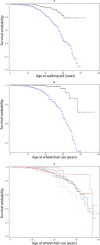Survival and severity in dominant cerebellar ataxias
- PMID: 25750924
- PMCID: PMC4338960
- DOI: 10.1002/acn3.156
Survival and severity in dominant cerebellar ataxias
Abstract
Inherited spinocerebellar ataxias (SCAs) are known to be genetically and clinically heterogeneous. Whether severity and survival are variable, however, is not known. We, therefore, studied survival and severity in 446 cases and 509 relatives with known mutations. Survival was 68 years [95% CI: 65-70] in 223 patients with polyglutamine expansions versus 80 years [73-84] in 23 with other mutations (P < 0.0001). Disability was also more severe in the former: at age 60, 30% were wheelchair users versus 3% with other SCAs (P < 0.001). This has implications for genetic counseling and the design of therapeutic trials.
Figures


References
-
- Durr A. Autosomal dominant cerebellar ataxias: polyglutamine expansions and beyond. Lancet Neurol. 2010;9:885–894. - PubMed
-
- Klockgether T. Handbook of ataxia disorders. New York: CRC Press; 2000.
-
- Tezenas du Montcel S, Charles P, Goizet C, et al. Factors influencing disease progression in autosomal dominant cerebellar ataxia and spastic paraplegia. Arch Neurol. 2012;69:500–508. - PubMed
LinkOut - more resources
Full Text Sources
Other Literature Sources

